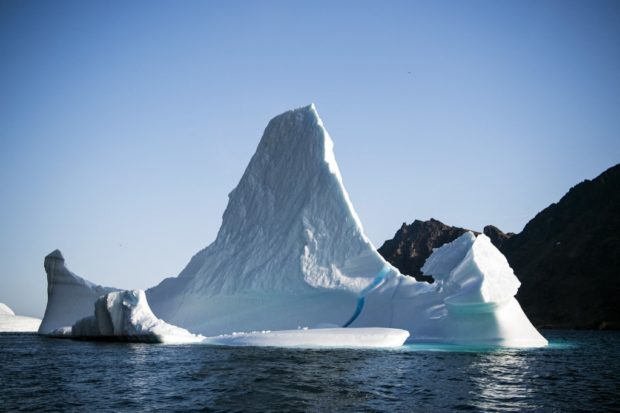Changing snowfall making Greenland darker and warmer—study

In this file photo taken on August 17, 2019 an iceberg is pictured near the island of Kulusuk (also spelled Qulusuk), in the Sermersooq municipality on the southeastern shore of Greenland. Greenland is becoming darker and warmer due to a weather pattern that is pushing fresh snowfall away from its ice sheet, a study said May 17, 2021. Photo by Jonathan NACKSTRAND / AFP
WASHINGTON — Greenland is becoming darker and warmer due to a weather pattern that is pushing fresh snowfall away from its ice sheet, a study said Monday.
A reduction in the amount of fresh, light-colored snow leaves more old and dark snow exposed on the surface — which in turn causes the ice sheet to absorb more heat and melt faster.
“As snow ages, even over hours to a few days, you get this reduction in reflectivity, and that’s why the fresh snow is so important,” said Erich Osterberg, an associate professor of earth sciences at Dartmouth College and co-author of the paper in Geophysical Research Letters.
Osterberg and colleagues attributed the decrease in snowfall to a weather phenomenon called “atmospheric blocking” — in which persistent high-pressure systems hover over the ice sheet for weeks at a time.
These systems, which have become more prevalent in the region since the 1990s, hold warmer air over western Greenland, reduce light-blocking cloud cover, and push snowstorms to the north.
Article continues after this advertisementThe result is a “triple whammy,” said Osterberg. “This all contributes to Greenland melting faster and faster.”
Article continues after this advertisementDirty snow
Some research has linked this phenomenon to human-driven climate change, but Osterberg noted further study is needed on why the blocking is happening.
“Given how important atmospheric blocking is to Greenland melting, I believe this is a critical target for research so we can improve our predictions of future sea level rise,” he told AFP in an email.
Co-author Gabriel Lewis added that it’s not just less snowfall driving the warming — it’s the different kind of snow that is left behind.
“Once it falls and sits on the surface of the ice sheet in the sun, it changes shape and the snow grains become larger over time,” he said.
It becomes more rounded and less reflective than newer, crystal-shaped snow.
According to the team’s calculations, a one percent change in reflectivity across Greenland’s ice sheet could cause an additional 25 gigatons of ice to be lost over three years.
The team trekked 2,700 miles (4,340 kilometers) across Greenland on snowmobiles to carry out two sampling and survey campaigns in the summers of 2016 and 2017, to try to determine the cause of the darkening, which had been observed by satellite imagery over decades.
One hypothesis had been that the snow was becoming dirtier, because of soot from air pollution.
But the researchers found only about one part per billion of impurities, dispelling this hypothesis.
According to research cited in the study, the Greenland ice sheet has warmed about 2.7 degrees Celsius (4.85 degrees Fahrenheit) since 1982, and the continent is experiencing its greatest melt and runoff rates in at least the last 450 years.